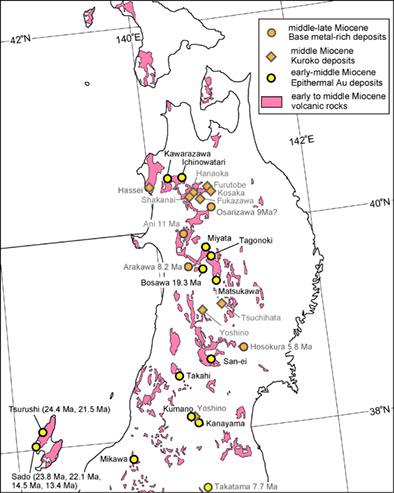当前位置:
X-MOL 学术
›
Resour. Geol.
›
论文详情
Our official English website, www.x-mol.net, welcomes your
feedback! (Note: you will need to create a separate account there.)
Early Miocene metallogenic event formed the Bosawa low‐sulfidation epithermal gold deposit, Northeast Japan arc
Resource Geology ( IF 1.1 ) Pub Date : 2020-09-21 , DOI: 10.1111/rge.12248 Teruhiro Suzuki 1 , Shota Satori 1 , Yuho Fujimaki 1 , Yasushi Watanabe 1
Resource Geology ( IF 1.1 ) Pub Date : 2020-09-21 , DOI: 10.1111/rge.12248 Teruhiro Suzuki 1 , Shota Satori 1 , Yuho Fujimaki 1 , Yasushi Watanabe 1
Affiliation

|
There are a number of epithermal Au‐Ag deposits in the Tohoku region of the Northeast Japan arc; however, these deposits have undergone limited exploration for over the past seven decades. This reconnaissance research study of the Bosawa deposit in Akita Prefecture was conducted to support future gold exploration in the Tohoku region. The Bosawa deposit is a vein‐type Au‐Ag deposit, with a production of 42,486 t of ore at 7.01 g/t Au and 14.9 g/t Ag recorded for the period from 1936 to 1957; mining started in the 18th century. The deposit consists of the Ohgiri vein system, which is hosted in felsic volcanic rocks of the Early Miocene Katsurabuchi Formation. The study included geological prospecting, ore description, K‐Ar dating, and fire assay analyses. The deposit is characterized by (a) strongly silicified host lapilli tuff fringed by pyrite‐adularia‐illite alteration; (b) presence of sulfide‐poor banded quartz veins with adularia; (c) abundance of bladed quartz in veins, pseudomorphs after bladed calcite; (d) presence of colloform opal texture in veins; and (e) simple ore mineralogy consisting of gold and argentite. These characteristics are typical of low‐sulfidation epithermal Au deposits. The K‐Ar age of adularia (19.33 ± 0.45 Ma) indicates that mineralization at Bosawa is distinctly older than the ages of other epithermal deposits in the Tohoku region but similar to the age of the initial mineralization episode of the Sado and Tsurushi deposits (24.4–22.1 Ma), Japan's second largest gold producer. This mineralization age coincides with the start of rifting of the Northeast Japan arc and separation from the Asian continent. As the felsic rocks related to this rifting event are widespread in the arc, and some are associated with epithermal gold deposits, the confirmation of typical low‐sulfidation style of mineralization in the Early Miocene provides evidence for a previously unrecognized metallogenic event in the Tohoku region.
中文翻译:

中新世早期成矿事件形成了日本东北弧的Bosawa低硫化超热金矿床
日本东北弧东北地区有许多超热金银沉积物。然而,在过去的七十年中,这些矿床受到了有限的勘探。这项针对秋田县Bosawa矿床的勘查研究旨在支持未来东北地区的金矿勘探。博萨瓦(Bosawa)矿床是脉状金银(Au-Ag)矿床,在1936年至1957年期间记录的金矿产量为42,486吨,金含量为7.01 g / t,银含量为14.9 g / t。采矿始于18世纪。该矿床由奥吉里(Ohgiri)脉系统组成,该系统位于中新世早期葛部组的长英质火山岩中。该研究包括地质勘探,矿石描述,K-Ar定年和火化验分析。该矿床的特征是:(a)由黄铁矿-金刚砂-伊利石蚀变带状的强烈硅化的寄主凝灰岩凝灰岩;(b)存在硫化物较差的带石英的带状石英脉;(c)叶片中有大量石英,方解石后为假晶;(d)静脉中存在大肠状蛋白石质地;(e)由金和银辉石组成的简单矿石矿物学。这些特征是低硫化超热金矿床的典型特征。Adularia的K-Ar年龄(19.33±0.45 Ma)表明,博萨瓦的矿化年龄明显长于东北地区其他超热矿床的年龄,但与佐渡和鹤鹤矿床的初始矿化时期相似(24.4 –22.1 Ma),日本第二大黄金生产国。这个矿化时代与日本东北弧开始裂谷并与亚洲大陆分离的时期相吻合。由于与此裂谷事件有关的长英质岩石广泛分布在弧中,有些与超热金矿床有关,对中新世早期典型的低硫成矿作用的证实为东北地区以前未被认识的成矿事件提供了证据。 。
更新日期:2020-09-29
中文翻译:

中新世早期成矿事件形成了日本东北弧的Bosawa低硫化超热金矿床
日本东北弧东北地区有许多超热金银沉积物。然而,在过去的七十年中,这些矿床受到了有限的勘探。这项针对秋田县Bosawa矿床的勘查研究旨在支持未来东北地区的金矿勘探。博萨瓦(Bosawa)矿床是脉状金银(Au-Ag)矿床,在1936年至1957年期间记录的金矿产量为42,486吨,金含量为7.01 g / t,银含量为14.9 g / t。采矿始于18世纪。该矿床由奥吉里(Ohgiri)脉系统组成,该系统位于中新世早期葛部组的长英质火山岩中。该研究包括地质勘探,矿石描述,K-Ar定年和火化验分析。该矿床的特征是:(a)由黄铁矿-金刚砂-伊利石蚀变带状的强烈硅化的寄主凝灰岩凝灰岩;(b)存在硫化物较差的带石英的带状石英脉;(c)叶片中有大量石英,方解石后为假晶;(d)静脉中存在大肠状蛋白石质地;(e)由金和银辉石组成的简单矿石矿物学。这些特征是低硫化超热金矿床的典型特征。Adularia的K-Ar年龄(19.33±0.45 Ma)表明,博萨瓦的矿化年龄明显长于东北地区其他超热矿床的年龄,但与佐渡和鹤鹤矿床的初始矿化时期相似(24.4 –22.1 Ma),日本第二大黄金生产国。这个矿化时代与日本东北弧开始裂谷并与亚洲大陆分离的时期相吻合。由于与此裂谷事件有关的长英质岩石广泛分布在弧中,有些与超热金矿床有关,对中新世早期典型的低硫成矿作用的证实为东北地区以前未被认识的成矿事件提供了证据。 。









































 京公网安备 11010802027423号
京公网安备 11010802027423号